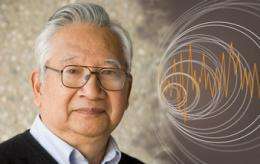Seismologist reflects on his firsthand experience of the Japanese earthquake

Eminent seismologist Hiroo Kanamori, Caltech's Smits Professor of Geophysics, Emeritus, has been studying the movement of the earth his entire career. On March 11 he was in Tokyo, experiencing firsthand the largest earthquake in the country's recorded history.
"It's hard to believe that it was a coincidence that I arrived there on the eve of 'a once in a thousand years' event," says Kanamori.
He says that when the University of Tokyo building he was in squeaked and began to shake—for a long time, with a gradual increase in intensity—he could tell that the earthquake was not centered nearby. Judging from the strength of the shaking, he estimated that the quake might be a magnitude 8 or larger.
Kanamori met up with fellow seismologists from the university when he evacuated the building. With no reliable source of information, they shared initial thoughts and assumptions about the event.
"Early reports said it was a 7.9, which seemed reasonable to me given what I know about the area," he says. "But when I heard that it was actually a 9, I was surprised."
Kanamori and others had previously theorized that where a plate is very young, it tends to produce big earthquakes, such as the event in Chile last year, which happened on a plate that is 10 million years old—a baby when it comes to tectonic plates.
"But where old plates are subducting, we don't normally have giant earthquakes," says Kanamori. "This explanation usually works. However, the plate off the coast of Tohoku where this earthquake occurred is old, about 130 million years. Thus, at first sight, this event was a big exception."
A deep knowledge of earthquakes is not the only expertise that informed his reactions to the event. In October of last year, Kanamori traveled to the coast near Sendai—an area close to the epicenter of the quake and hit hard by the tsunami—with Luis Rivera, a seismologist at the Institut de Physique du Globe de Strasbourg, with whom Kanamori has been working on improving tsunami early-warning systems for the last several years.
"We walked the beach for two days to look at the coastal topography and try to understand how bad it might be when a tsunami came," he recalls. "It was very obvious that it would be devastating—there are no prominent roads or trails that lead to the nearby highlands"
Kanamori emphasizes that the rapid dissemination of information after a big event is extremely important to warning systems for tsunamis and recovery efforts for earthquakes. He says that information needs to be collected on a global scale, since local systems often fail during a natural disaster. This requires good coordination between agencies in different countries.
"In the case of an emergency, they can exchange information and take immediate action," he says.
Kanamori is also quick to point out that the field of seismology is rapidly advancing its methods for data collection and analysis so that we can improve the way we deal with emergencies. But at the end of the day, we have to prepare for the unexpected.
"In our science, it's very difficult to prove anything because you can't experiment. You have to rely on nature," he says. "Whatever happens in nature, you cannot predict 100 percent, so building robust infrastructures using rapid reliable information to prepare for the unexpected is very important.”
Provided by California Institute of Technology

















